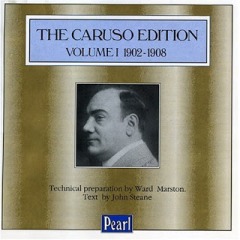Enrico Caruso - The Caruso Edition. Vol. 1 (1993)
Enrico Caruso - The Caruso Edition. Vol. 1 (1993)

01 - Tu non mi vuoi piu 02 - Tosca- E lucevan le stelle 03 - Les Huguenots - Qui sotto il ciel 04 - Rigoletto- Questa o quella 05 - Rigoletto- La donna e mobile 06 - L'elisir d'amore- Una furtiva lagrima 07 - Aida- Celeste Aida 08 - Tosca- Recondita armonia 09 - Tosca- E lucevan le stelle 10 - Cavelleria rusticana- Siciliana 11 - I pagliacci- Vesti la giubba 12 - Manon- Chiudo gli occhi (Il sogno) 13 - Mattinata 14 - I pescatori de perle- Mi par d'udir ancor 15 - Don Pasquale- Com'e gentil (Serenata) 16 - Carmen- Il fior che avevi a me 17 - Les Hugenots- Bianca al par di neve alpina 18 - La gioconda- Cielo e mar! 19 - Cavelleria rusticava- Brindisi 20 - Martha- M'appari tutt'amor 21 - La boheme- Che gelida manina 22 - Faust- Salut, demeure chaste et pure 23 - Il trovatore- Di quella pira 24 - La favorita- Spirto gentil, ne'sogni miei Enrico Caruso - Tenor Bessie Abott - Soprano Mario Ancona - Baritone Francesco Daddi – Baritone Geraldine Farrar – Soprano Louise Homer - Mezzo-Soprano Nellie Melba – Soprano Antonio Scotti – Baritone Marcella Sembrich – Soprano Gina Severina - Mezzo-Soprano Gina Viafora - Mezzo-Soprano Marcel Journet - Bass Francesco Cilèa - Piano Salvatore Cottone - Piano Luigi Denza - Piano Ruggero Leoncavallo – Piano
Enrico Caruso, original name Errico Caruso (born Feb. 25, 1873, Naples, Italy—died Aug. 2, 1921, Naples), the most admired Italian operatic tenor of the early 20th century and one of the first musicians to document his voice on gramophone recordings.
Caruso was born into a poor family. Although he was a musical child who sang Neapolitan folk songs everywhere and joined his parish choir at the age of nine, he received no formal music training until his study with Guglielmo Vergine at age 18. Within three years, in 1894, he made his operatic debut, in Mario Morelli’s L’Amico Francesco in Naples at the Teatro Nuovo. Four years later, after adding a number of impressive roles to his repertoire, he was asked to create the role of Loris in the premiere of Umberto Giordano’s Fedora in Milan. He was a sensation and soon had engagements in Moscow, St. Petersburg (Russia), and Buenos Aires. He made his La Scala debut with La Bohème (1900). In 1901, after being unfavourably received in his performance in L’elisir d’amore in Naples, he vowed never again to sing in Naples, and he kept his word.
Caruso then created the chief tenor parts in Adriana Lecouvreur, Germania, and La fanciulla del West, and for the La Scala company the tenor roles in Le Maschere and L’elisir d’amore. World recognition came in the spring of 1902 after he sang in La Bohème at Monte Carlo and in Rigoletto at London’s Covent Garden. He made his American debut in Rigoletto at the opening night of the Metropolitan Opera in New York City on Nov. 23, 1903, and continued to open each season there for the next 17 years, presenting 36 roles in all. His last public appearance—his 607th performance with the Metropolitan—was as Eléazar in La Juive (Dec. 24, 1920).
Caruso became the most celebrated and highest paid of his contemporaries worldwide. He made recordings of about 200 operatic excerpts and songs; many of them are still being published. His voice was sensuous, lyrical, and vigorous in dramatic outbursts and became progressively darker in timbre in his later years. Its appealing tenor qualities were unusually rich in lower registers and abounded in warmth, vitality, and smoothness. --- britannica.com
download: uploaded anonfiles yandex 4shared solidfiles mediafire mega filecloudio
Last Updated (Wednesday, 06 November 2013 11:41)








